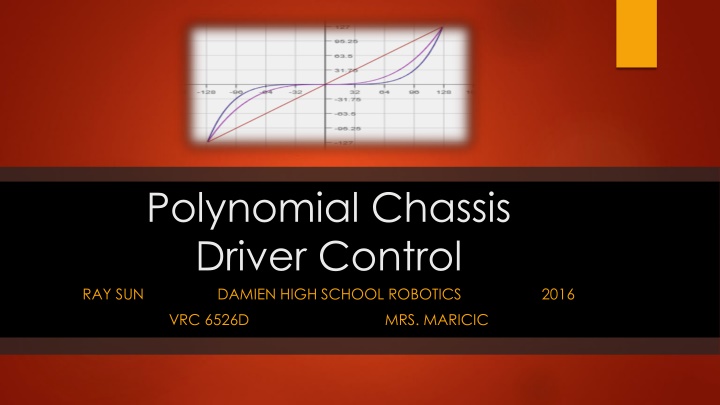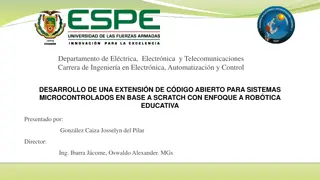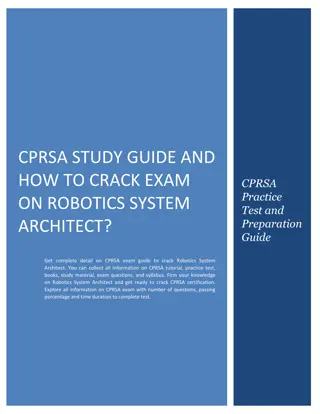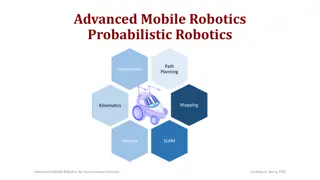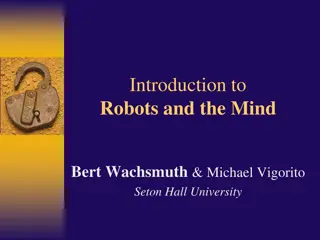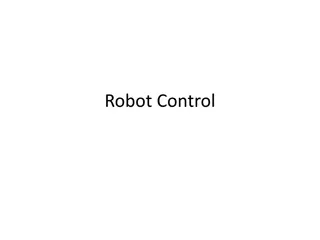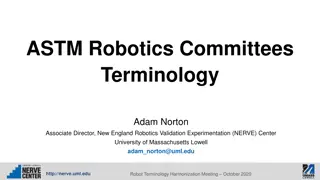Optimizing Motor Control for Precise Robotics Performance
This presentation delves into the challenges of achieving precise control in robotic systems through an exploration of motor speed adjustments based on joystick input. It discusses the limitations of conventional approaches and proposes innovative solutions using non-linear polynomial functions to enhance motor efficiency and accuracy.
Uploaded on Feb 16, 2025 | 2 Views
Download Presentation

Please find below an Image/Link to download the presentation.
The content on the website is provided AS IS for your information and personal use only. It may not be sold, licensed, or shared on other websites without obtaining consent from the author.If you encounter any issues during the download, it is possible that the publisher has removed the file from their server.
You are allowed to download the files provided on this website for personal or commercial use, subject to the condition that they are used lawfully. All files are the property of their respective owners.
The content on the website is provided AS IS for your information and personal use only. It may not be sold, licensed, or shared on other websites without obtaining consent from the author.
E N D
Presentation Transcript
Polynomial Chassis Driver Control DAMIEN HIGH SCHOOL ROBOTICS VRC 6526D RAY SUN 2016 MRS. MARICIC
This presentation assumes basic knowledge of ROBOTC and driver-control programming. As an example for explication, a simple two-motor chassis will be used.
Theory WHY MOTOR[] = VEXRT() IS INEFFICIENT
The Problem of Precise Driving Normal chassis control code directly assigns the motors the value of the joystick. If both joysticks are pushed to maximum forward position (127), the Cortex makes the following substitution and the motors run at full speed in the positive direction.
The Problem of Precise Driving Suppose motor speed is represented by v and joystick input by j The expression motor[] = vexRT[] essentially v = j j must be limited to [-127, 127]. Thus, so is v. is
The Problem of Precise Driving However, driving a robot precisely using low joystick values proves problematic. At small joystick values, the motor speed is too large. In other words, for low values of j, the corresponding v values (which are equal to j) are too large. How can we make the motor speed for small joystick assignments smaller?
Theory THE SOLUTION
Bad Solution : v = kj At first glance, adding a constant multiplier to the v = j relationship may seem a good ide ( v = kj ). However, this will lower the top speed of the motor, since a joystick value of 127 does not translate to a motor speed of 127. The graph shows v = 0.5 j. Clearly the maximum motor speed is inadequate.
A Better Solution : Polynomials What if the relationship between v and j were non-linear? Quadratic? Suppose v = j . As j , the joystick assignment, increases from zero to 127, v , the motor speed, increases slowly at first but then rapidly grows producing the desired effect. Problem: v(127) does not equal 127 (rather, 127 or 16,129). v(127) has to equal 127 to retain maximum speed. Solution: introduce a scaling constant k so that v(127) = k(127) = 127
A Better Solution : Polynomials In this example v = k(j) , k should equal (1/127). However, there is still a major problem. What? (Look at the negative j regions of the graph).
A Better Solution : Polynomials A negative joystick input should not result in a positive motor speed! The graph should be cubic in shape. There are two possible theoretical solutions: 1. Use an odd power of j so that the graph is cubic. However, higher powers produce situations in which the low-speed limiting effect is extremely pronounced.
A Better Solution : Polynomials 1. Alternatively, use two functions (piecewise). One function applies for positive values of j, and the other applies for negative values. This is the more versatile solution since any power can be used, rather than only odds v =
ROBOTC Implementation ROBOTC handles exponents as such: Examples: What does each example mean?
ROBOTC Implementation Example 1: If the desired power is odd, the motor speed assignment does not need to account for negative joystick inputs A negative input will yield a negative output (unless if the power is even). ? ??????? This code reflects ? =
ROBOTC Implementation Example 2: Coding this relationship using if-statements to express the piecewise function necessary for even powers of j. The code reflects tank control programming. v =
ROBOTC Implementation This example may be refined with a return value function. These functions, when called, calculate a number and return that value to the Cortex, substituting it in place of the function declaration. For an integer return, the return function is declared and structured as such: int functionName (int inputVariable) { int returnVariable; (Do stuff to find returnVariable from inputVariable ) return returnVariable; }
ROBOTC Implementation Example 3:
ROBOTC Implementation Theory Revisited Upon close inspection, it seems that the value of k is equal to one over 127 raised to one less than the power of j. ? ? ? ? ?????or ? = ??, ? ??? = ???; ? = ??? ? ? ? ? ???????or ? = Therefore, this is true: ??, ? 127 = 127; ? = ??? ? ? ? ??,? ??? = ???,? > ? ? = ???
ROBOTC Implementation Thus, in ROBOTC a constant integer may be utilized to store the power (n in the previous equation) for ease of modification. The combination of this variable technique and the return value function (Example 2) provides the greatest versatility for polynomial motor speed control.
ROBOTC Implementation Example 4 :
Sample Code The code snippets within this presentation were taken from Polynomial Chassis Driver Control Examples available on Damien Robotics websites or directly from Ray Sun. Pinout: leftMotor in motor port 2 rightMotor in motor port 3 Remember that vexRT(Ch3) is the value of the y-axis of the left joystick and vexRT(Ch2) is that of the right joystick.
Alternatives Of course, a polynomial relationship between motor speed and joystick input is not the only option. Piecewise lines, exponentials, etc. etc. etc. However, the polynomial perhaps necessitates the least amount of Cortex memory. Why does this matter? Isn t the simple motor[] = vexRT() relationship fine anyway? motor[] = vexRT() works. However, the non-linear relationship facilitates more precise robot control. In VRC, with rather small scoring object goals, this may be crucial for programming precision.
Additional Applications The polynomial technique is applicable to other types of chassis and even any mechanism controlled by a joystick Example: Sample holonomic drive code utilizing the same return value function. joy_Y , joy_X , and joy_R are variables declared elsewhere that store joystick values.
